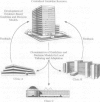Abstract
Clinical practice guidelines have enormous potential to improve the quality of and accountability in health care. Making the most of this potential should become easier as guideline developers integrate guidelines within information systems and electronic medical records. A major barrier to such integration is the lack of computing infrastructure in many clinical settings. To successfully implement guidelines in information systems, developers must create more specific recommendations than those that have been required for traditional guidelines. Using reusable software components to create guidelines can make the development of protocols faster and less expensive. In addition, using decision models to produce guidelines enables developers to structure guideline problems systematically, to prioritize information acquisition, to develop site-specific guidelines, and to evaluate the cost-effectiveness of the explicit incorporation of patient preferences into guideline recommendations. Ongoing research provides a foundation for the use of guideline development tools that can help developers tailor guidelines appropriately to their practice settings. This article explores how medical informatics can help clinicians find, use, and create practice guidelines.
Full text
PDF

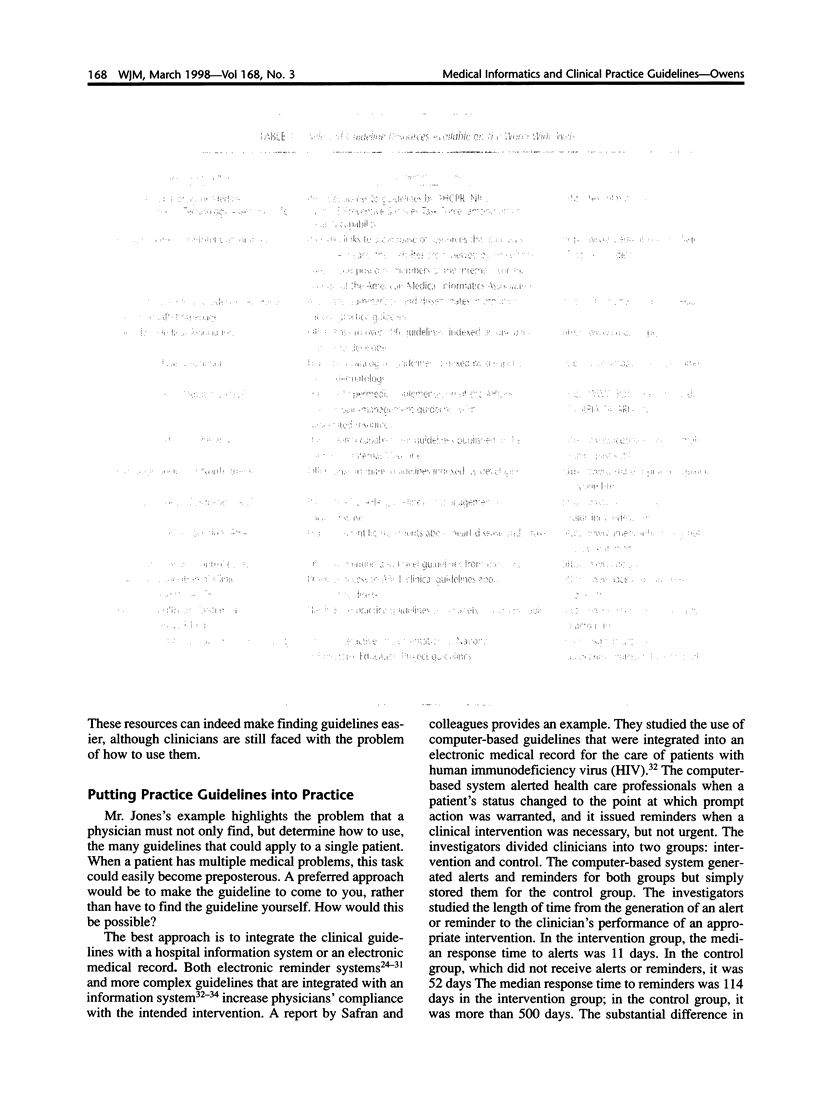


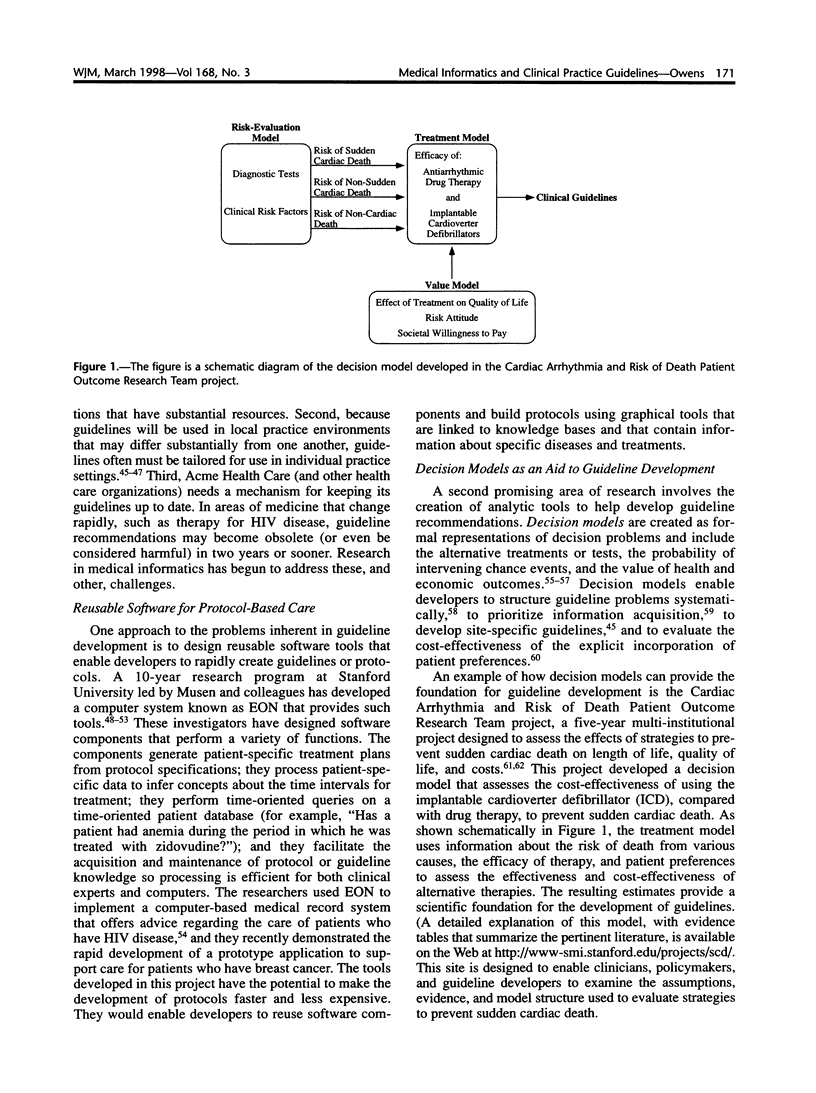

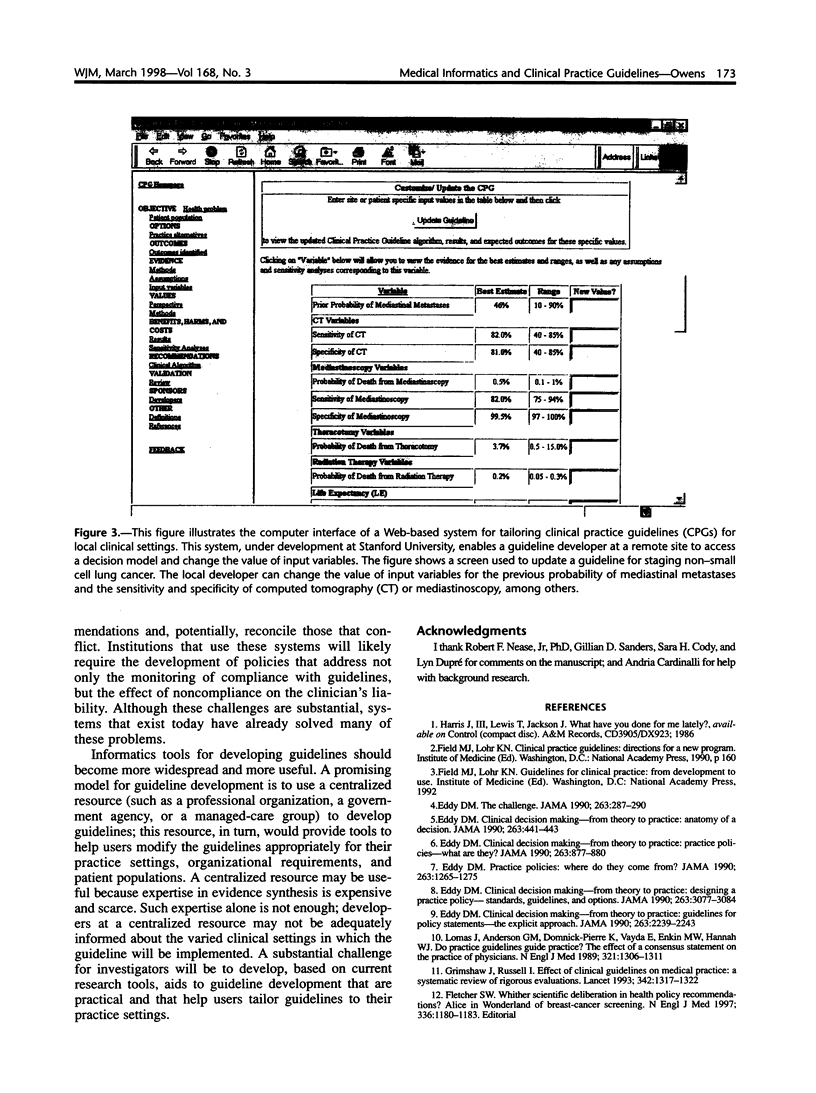
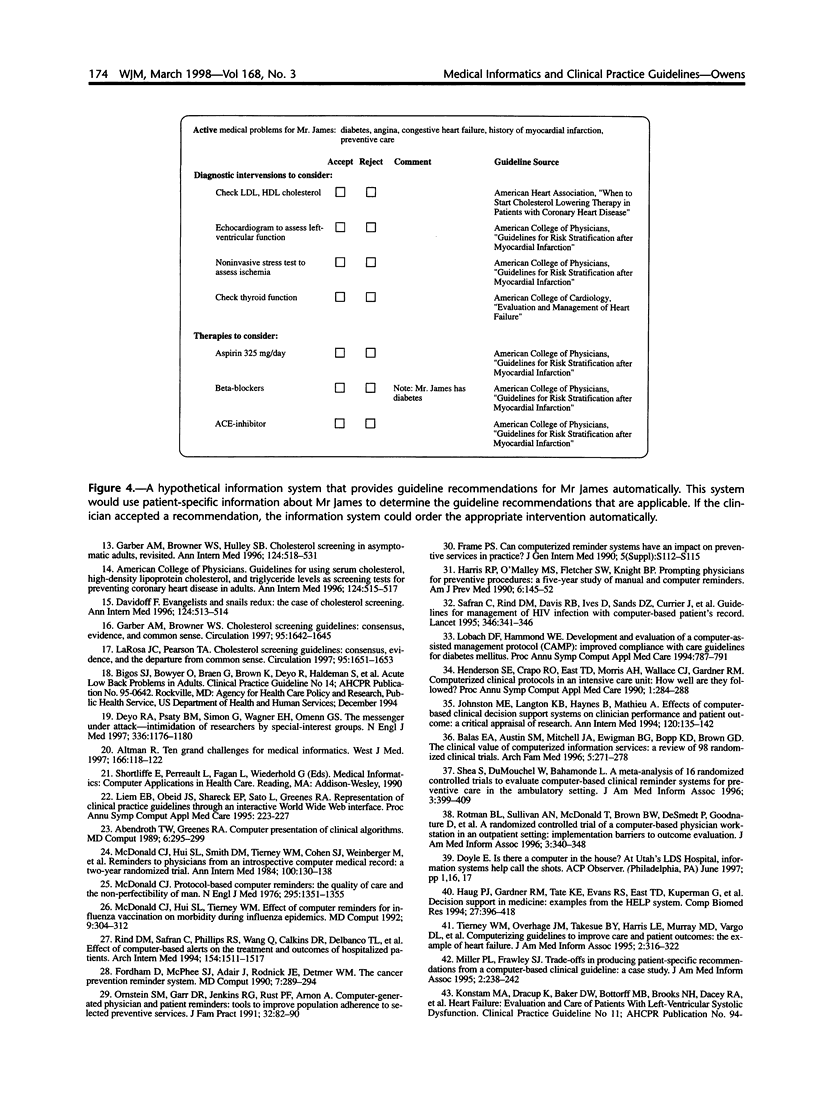
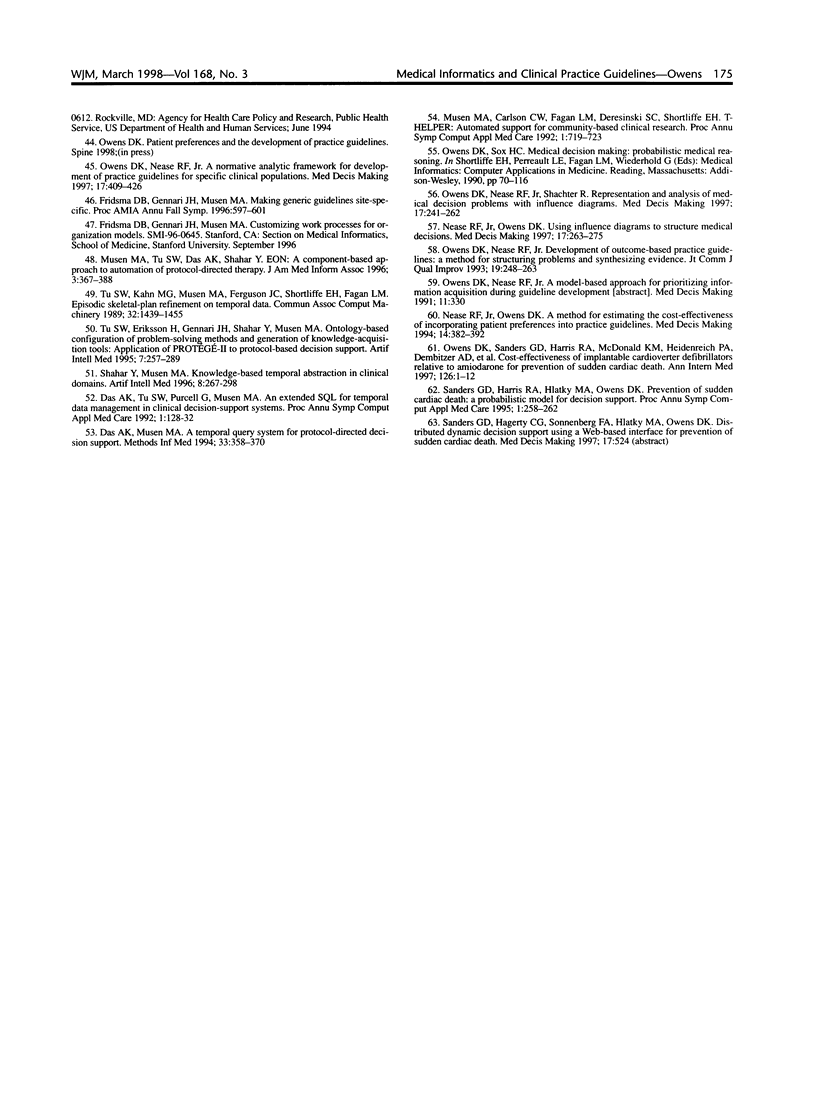
Images in this article
Selected References
These references are in PubMed. This may not be the complete list of references from this article.
- Abendroth T. W., Greenes R. A. Computer presentation of clinical algorithms. MD Comput. 1989 Sep-Oct;6(5):295–299. [PubMed] [Google Scholar]
- Altman R. B. Informatics in the care of patients: ten notable challenges. West J Med. 1997 Feb;166(2):118–122. [PMC free article] [PubMed] [Google Scholar]
- Appl Wolfgang. [Stellungnahme des Deutschen Tierschutzbundes e.V.] ALTEX. 1995;12(4):227–228. [PubMed] [Google Scholar]
- Balas E. A., Austin S. M., Mitchell J. A., Ewigman B. G., Bopp K. D., Brown G. D. The clinical value of computerized information services. A review of 98 randomized clinical trials. Arch Fam Med. 1996 May;5(5):271–278. doi: 10.1001/archfami.5.5.271. [DOI] [PubMed] [Google Scholar]
- Das A. K., Musen M. A. A temporal query system for protocol-directed decision support. Methods Inf Med. 1994 Oct;33(4):358–370. [PubMed] [Google Scholar]
- Das A. K., Tu S. W., Purcell G. P., Musen M. A. An extended SQL for temporal data management in clinical decision-support systems. Proc Annu Symp Comput Appl Med Care. 1992:128–132. [PMC free article] [PubMed] [Google Scholar]
- Davidoff F. Evangelists and snails redux: the case of cholesterol screening. Ann Intern Med. 1996 Mar 1;124(5):513–514. doi: 10.7326/0003-4819-124-5-199603010-00011. [DOI] [PubMed] [Google Scholar]
- Deyo R. A., Psaty B. M., Simon G., Wagner E. H., Omenn G. S. The messenger under attack -- intimidation of researchers by special-interest groups. N Engl J Med. 1997 Apr 17;336(16):1176–1180. doi: 10.1056/NEJM199704173361611. [DOI] [PubMed] [Google Scholar]
- Eddy D. M. Clinical decision making: from theory to practice. Anatomy of a decision. JAMA. 1990 Jan 19;263(3):441–443. doi: 10.1001/jama.263.3.441. [DOI] [PubMed] [Google Scholar]
- Eddy D. M. Clinical decision making: from theory to practice. Designing a practice policy. Standards, guidelines, and options. JAMA. 1990 Jun 13;263(22):3077–3084. doi: 10.1001/jama.263.22.3077. [DOI] [PubMed] [Google Scholar]
- Eddy D. M. Clinical decision making: from theory to practice. Guidelines for policy statements: the explicit approach. JAMA. 1990 Apr 25;263(16):2239-40, 2243. doi: 10.1001/jama.263.16.2239. [DOI] [PubMed] [Google Scholar]
- Eddy D. M. Clinical decision making: from theory to practice. Practice policies --what are they? JAMA. 1990 Feb 9;263(6):877-8, 880. doi: 10.1001/jama.263.6.877. [DOI] [PubMed] [Google Scholar]
- Eddy D. M. Practice policies: where do they come from? JAMA. 1990 Mar 2;263(9):1265–passim. doi: 10.1001/jama.263.9.1265. [DOI] [PubMed] [Google Scholar]
- Eddy D. M. The challenge. JAMA. 1990 Jan 12;263(2):287–290. [PubMed] [Google Scholar]
- Fletcher S. W. Whither scientific deliberation in health policy recommendations? Alice in the Wonderland of breast-cancer screening. N Engl J Med. 1997 Apr 17;336(16):1180–1183. doi: 10.1056/NEJM199704173361612. [DOI] [PubMed] [Google Scholar]
- Fordham D., McPhee S. J., Bird J. A., Rodnick J. E., Detmer W. M. The Cancer Prevention Reminder System. MD Comput. 1990 Sep-Oct;7(5):289–295. [PubMed] [Google Scholar]
- Fridsma D. B., Gennari J. H., Musen M. A. Making generic guidelines site-specific. Proc AMIA Annu Fall Symp. 1996:597–601. [PMC free article] [PubMed] [Google Scholar]
- Garber A. M., Browner W. S. Cholesterol screening guidelines. Consensus, evidence, and common sense. Circulation. 1997 Mar 18;95(6):1642–1645. doi: 10.1161/01.cir.95.6.1642. [DOI] [PubMed] [Google Scholar]
- Garber A. M., Browner W. S., Hulley S. B. Cholesterol screening in asymptomatic adults, revisited. Part 2. Ann Intern Med. 1996 Mar 1;124(5):518–531. doi: 10.7326/0003-4819-124-5-199603010-00013. [DOI] [PubMed] [Google Scholar]
- Grimshaw J. M., Russell I. T. Effect of clinical guidelines on medical practice: a systematic review of rigorous evaluations. Lancet. 1993 Nov 27;342(8883):1317–1322. doi: 10.1016/0140-6736(93)92244-n. [DOI] [PubMed] [Google Scholar]
- Harris R. P., O'Malley M. S., Fletcher S. W., Knight B. P. Prompting physicians for preventive procedures: a five-year study of manual and computer reminders. Am J Prev Med. 1990 May-Jun;6(3):145–152. [PubMed] [Google Scholar]
- Haug P. J., Gardner R. M., Tate K. E., Evans R. S., East T. D., Kuperman G., Pryor T. A., Huff S. M., Warner H. R. Decision support in medicine: examples from the HELP system. Comput Biomed Res. 1994 Oct;27(5):396–418. doi: 10.1006/cbmr.1994.1030. [DOI] [PubMed] [Google Scholar]
- Johnston M. E., Langton K. B., Haynes R. B., Mathieu A. Effects of computer-based clinical decision support systems on clinician performance and patient outcome. A critical appraisal of research. Ann Intern Med. 1994 Jan 15;120(2):135–142. doi: 10.7326/0003-4819-120-2-199401150-00007. [DOI] [PubMed] [Google Scholar]
- LaRosa J. C., Pearson T. A. Cholesterol screening guidelines consensus, evidence, and the departure from common sense. Circulation. 1997 Mar 18;95(6):1651–1653. doi: 10.1161/01.cir.95.6.1651. [DOI] [PubMed] [Google Scholar]
- Liem E. B., Obeid J. S., Shareck E. P., Sato L., Greenes R. A. Representation of clinical practice guidelines through an interactive World-Wide-Web interface. Proc Annu Symp Comput Appl Med Care. 1995:223–227. [PMC free article] [PubMed] [Google Scholar]
- Lobach D. F., Hammond W. E. Development and evaluation of a Computer-Assisted Management Protocol (CAMP): improved compliance with care guidelines for diabetes mellitus. Proc Annu Symp Comput Appl Med Care. 1994:787–791. [PMC free article] [PubMed] [Google Scholar]
- Lomas J., Anderson G. M., Domnick-Pierre K., Vayda E., Enkin M. W., Hannah W. J. Do practice guidelines guide practice? The effect of a consensus statement on the practice of physicians. N Engl J Med. 1989 Nov 9;321(19):1306–1311. doi: 10.1056/NEJM198911093211906. [DOI] [PubMed] [Google Scholar]
- McDonald C. J., Hui S. L., Smith D. M., Tierney W. M., Cohen S. J., Weinberger M., McCabe G. P. Reminders to physicians from an introspective computer medical record. A two-year randomized trial. Ann Intern Med. 1984 Jan;100(1):130–138. doi: 10.7326/0003-4819-100-1-130. [DOI] [PubMed] [Google Scholar]
- McDonald C. J., Hui S. L., Tierney W. M. Effects of computer reminders for influenza vaccination on morbidity during influenza epidemics. MD Comput. 1992 Sep-Oct;9(5):304–312. [PubMed] [Google Scholar]
- McDonald C. J. Protocol-based computer reminders, the quality of care and the non-perfectability of man. N Engl J Med. 1976 Dec 9;295(24):1351–1355. doi: 10.1056/NEJM197612092952405. [DOI] [PubMed] [Google Scholar]
- Miller P. L., Frawley S. J. Trade-offs in producing patient-specific recommendations from a computer-based clinical guideline: a case study. J Am Med Inform Assoc. 1995 Jul-Aug;2(4):238–242. doi: 10.1136/jamia.1995.96010392. [DOI] [PMC free article] [PubMed] [Google Scholar]
- Musen M. A., Carlson R. W., Fagan L. M., Deresinski S. C., Shortliffe E. H. T-HELPER: automated support for community-based clinical research. Proc Annu Symp Comput Appl Med Care. 1992:719–723. [PMC free article] [PubMed] [Google Scholar]
- Musen M. A., Tu S. W., Das A. K., Shahar Y. EON: a component-based approach to automation of protocol-directed therapy. J Am Med Inform Assoc. 1996 Nov-Dec;3(6):367–388. doi: 10.1136/jamia.1996.97084511. [DOI] [PMC free article] [PubMed] [Google Scholar]
- Nease R. F., Jr, Owens D. K. A method for estimating the cost-effectiveness of incorporating patient preferences into practice guidelines. Med Decis Making. 1994 Oct-Dec;14(4):382–392. doi: 10.1177/0272989X9401400409. [DOI] [PubMed] [Google Scholar]
- Nease R. F., Jr, Owens D. K. Use of influence diagrams to structure medical decisions. Med Decis Making. 1997 Jul-Sep;17(3):263–275. doi: 10.1177/0272989X9701700302. [DOI] [PubMed] [Google Scholar]
- Ornstein S. M., Garr D. R., Jenkins R. G., Rust P. F., Arnon A. Computer-generated physician and patient reminders. Tools to improve population adherence to selected preventive services. J Fam Pract. 1991 Jan;32(1):82–90. [PubMed] [Google Scholar]
- Owens D. K., Nease R. F., Jr A normative analytic framework for development of practice guidelines for specific clinical populations. Med Decis Making. 1997 Oct-Dec;17(4):409–426. doi: 10.1177/0272989X9701700406. [DOI] [PubMed] [Google Scholar]
- Owens D. K., Nease R. F., Jr Development of outcome-based practice guidelines: a method for structuring problems and synthesizing evidence. Jt Comm J Qual Improv. 1993 Jul;19(7):248–263. doi: 10.1016/s1070-3241(16)30005-0. [DOI] [PubMed] [Google Scholar]
- Owens D. K., Sanders G. D., Harris R. A., McDonald K. M., Heidenreich P. A., Dembitzer A. D., Hlatky M. A. Cost-effectiveness of implantable cardioverter defibrillators relative to amiodarone for prevention of sudden cardiac death. Ann Intern Med. 1997 Jan 1;126(1):1–12. doi: 10.7326/0003-4819-126-1-199701010-00001. [DOI] [PubMed] [Google Scholar]
- Owens D. K., Shachter R. D., Nease R. F., Jr Representation and analysis of medical decision problems with influence diagrams. Med Decis Making. 1997 Jul-Sep;17(3):241–262. doi: 10.1177/0272989X9701700301. [DOI] [PubMed] [Google Scholar]
- Rind D. M., Safran C., Phillips R. S., Wang Q., Calkins D. R., Delbanco T. L., Bleich H. L., Slack W. V. Effect of computer-based alerts on the treatment and outcomes of hospitalized patients. Arch Intern Med. 1994 Jul 11;154(13):1511–1517. [PubMed] [Google Scholar]
- Rotman B. L., Sullivan A. N., McDonald T. W., Brown B. W., DeSmedt P., Goodnature D., Higgins M. C., Suermondt H. J., Young C., Owens D. K. A randomized controlled trial of a computer-based physician workstation in an outpatient setting: implementation barriers to outcome evaluation. J Am Med Inform Assoc. 1996 Sep-Oct;3(5):340–348. doi: 10.1136/jamia.1996.97035025. [DOI] [PMC free article] [PubMed] [Google Scholar]
- Safran C., Rind D. M., Davis R. B., Ives D., Sands D. Z., Currier J., Slack W. V., Makadon H. J., Cotton D. J. Guidelines for management of HIV infection with computer-based patient's record. Lancet. 1995 Aug 5;346(8971):341–346. doi: 10.1016/s0140-6736(95)92226-1. [DOI] [PubMed] [Google Scholar]
- Sanders G. D., Harris R. A., Hlatky M. A., Owens D. K. Prevention of sudden cardiac death: a probabilistic model for decision support. Proc Annu Symp Comput Appl Med Care. 1995:258–262. [PMC free article] [PubMed] [Google Scholar]
- Shahar Y., Musen M. A. Knowledge-based temporal abstraction in clinical domains. Artif Intell Med. 1996 Jul;8(3):267–298. doi: 10.1016/0933-3657(95)00036-4. [DOI] [PubMed] [Google Scholar]
- Shea S., DuMouchel W., Bahamonde L. A meta-analysis of 16 randomized controlled trials to evaluate computer-based clinical reminder systems for preventive care in the ambulatory setting. J Am Med Inform Assoc. 1996 Nov-Dec;3(6):399–409. doi: 10.1136/jamia.1996.97084513. [DOI] [PMC free article] [PubMed] [Google Scholar]
- Tierney W. M., Overhage J. M., Takesue B. Y., Harris L. E., Murray M. D., Vargo D. L., McDonald C. J. Computerizing guidelines to improve care and patient outcomes: the example of heart failure. J Am Med Inform Assoc. 1995 Sep-Oct;2(5):316–322. doi: 10.1136/jamia.1995.96073834. [DOI] [PMC free article] [PubMed] [Google Scholar]
- Tu S. W., Eriksson H., Gennari J. H., Shahar Y., Musen M. A. Ontology-based configuration of problem-solving methods and generation of knowledge-acquisition tools: application of PROTEGE-II to protocol-based decision support. Artif Intell Med. 1995 Jun;7(3):257–289. doi: 10.1016/0933-3657(95)00006-r. [DOI] [PubMed] [Google Scholar]



